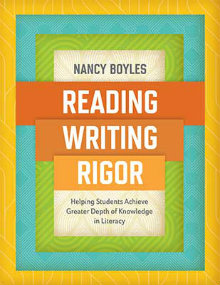Achieving More Depth of Knowledge in Literacy
Reading, Writing, Rigor: Helping Students Achieve Greater Depth of Knowledge in Literacy
By Nancy Boyles
(ASCD, 2018 – Learn more)

Reading, Writing, Rigor by Nancy Boyles offers practical tools to increase student learning in reading and writing. Boyles packs these 199 pages with information, including numerous resources, strategies, and techniques to support teachers.
She writes:
“We don’t have to throw out everything we’ve ever known about teaching and learning to get rigor right. Rather, the charge is to rethink our current practices, tweaking as necessary and enriching our teaching with a few new high-yield strategies that have great turnaround potential.” (p. 6)

- precision in identifying the best textual evidence,
- independence in applying literacy skills and concepts accurately,
- insight into content and craft, based on depth of reasoning; and
- creativity in synthesizing information, often from multiple sources or points of view. (p.2)
In the first four chapters, the author unpacks the Depth of Knowledge (DOK) levels. This can become research-heavy at times, so be prepared to stop often to digest and reflect!
I believe that Boyles reaches her goal of supporting teachers’ “efforts to help students achieve and demonstrate rigor in their literacy learning.” (p.11) Additionally, there are “bottom line” summaries throughout the book and a chart called The Book at a Glance found on page 199 that help with the rich but sometimes dense information.
These topics are discussed for each DOK level in chapters one through four:
- Understanding Underlying Principles: The Rigor at Each Depth of Knowledge
- Measuring Depth of Knowledge on Standards-Based Assessments
- Aligning Rigor and Standards
- Aligning Rigor and Text Complexity
- Aligning Rigor and Close Reading
- Aligning Rigor and Student Interaction
- Aligning Rigor and the Reading-Writing Connection
- Aligning Rigor and Formative Assessment
The remaining three chapters identify Materials to Support DOK in Literacy Instruction.
- Chapter 5 Sample Lessons and Planning Templates
- 6 Books and Other Resources That Inspire Deep Thinking
- 7 Teaching Tools and Resources
“Depth of Knowledge 1 is the foundation for all of the other levels” (p. 17); it is about evidence. Students face challenges in identifying evidence when they do not understand the meaning behind the vocabulary in the test item. While teaching the concepts (e.g., theme, tone, character trait, etc.) the necessary academic vocabulary must also be included.
The author reminds us that academic vocabulary is needed at all levels of DOK. In order for students to grow their vocabularies and have an efficient command of literary vocabulary, she suggests using Anchor Charts. These visual reminders provide support for all students as they move toward academic success.
Anchor Charts are helpful because assessments often use different words for the same task. In assessment items, there is no differentiation between theme, central idea, main idea, etc. Chapter 7 includes anchor charts along with graphic organizers that can be used for both literary and informational texts.
Boyles spells out what educators need to do to guide students to greater depths of knowledge. The abundance of released assessment items, along with practical approach to instruction, makes Reading, Writing, Rigor: Helping Students Achieve Greater Depth of Knowledge in Literacy a good investment of both time and money.
Educators who are overwhelmed by standards, reading, writing, and assessment will find encouragement in these gems from the book:
“You will need to fasten your seatbelt for Standard 5 (text features and structure) because this standard promises to be a wild ride for Depth of Knowledge 3.” (p.74)
“All writing instruction does not need to culminate in a whole published story, essay, or any other kind of writing.” (p.77)
“When you ask the right question, rigor happens!” (p.84)
“We need to recognize that developing writing competence is a years-long journey that all teachers need to embrace.” (p.110)
Do not be turned off or mislead by the title! Even if your district is not big into DOK and you find yourself gagging on the word “rigor,” do not overlook this excellent resource. Whatever your position – teacher, coach, administrator – you will find useful tools, assessment items, and instructional practices.
A free study guide for this book is available from ASCD.
Former eighth grade teacher Anne Anderson is an educational consultant known for her practical ideas and engaging ELA workshops. Anne’s goal is to help teachers help students. Her positive approach and sense of humor bring encouragement to her audiences. She loves showing teachers how to use whatever resources they have – or don’t have – to enhance learning. Anne seeks to provide educators with practical solutions to teaching and learning problems. Visit her website and subscribe to her bi-monthly newsletter, Spotlight on Success, there or by texting ANNEANDERSON to 22828.






























